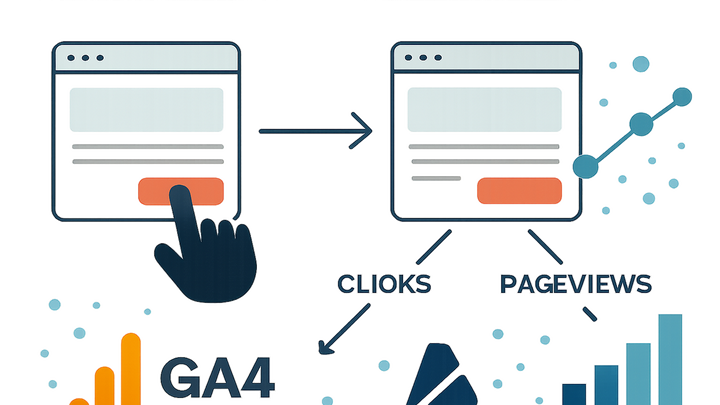Published on 2025-06-28T08:10:16Z
What is Clickstream? Examples of Clickstream Analytics
Clickstream refers to the sequential recording of user interactions - such as clicks, pageviews, and form submissions - on a website. These events, captured in order, create a detailed map of a user’s journey. In the analytics industry, clickstream data fuels insights into navigation patterns, conversion funnels, and engagement bottlenecks. Whether implemented through cookie-free solutions like PlainSignal or platforms such as Google Analytics 4 (GA4), clickstream tracking is essential for data-driven decision-making. By analyzing this granular data, businesses can optimize user experiences, refine content strategies, and support advanced use cases like personalization and predictive modeling.
Clickstream
Sequential recording of user interactions on a website (clicks, pageviews) for in-depth behavioral analysis.
Overview of Clickstream Data
Clickstream data represents the chronological sequence of user actions on a website, capturing how users navigate pages and engage with elements. It encompasses every click, page load, and event, forming the raw logs that drive behavioral analysis.
-
Definition
A clickstream is the ordered set of user interactions - clicks, navigations, and events - recorded as they occur on a website.
-
How it's captured
Tracking scripts embedded in web pages listen for events and send payloads with metadata to analytics endpoints.
-
Pageview events
Triggered when a user loads or reloads a page.
-
Click events
Recorded when a user clicks on links, buttons, or interactive elements.
-
Custom events
Defined by developers to capture interactions like form submissions or video plays.
-
Key Components of Clickstream Analysis
Breaking down clickstream data into its core elements helps teams standardize reporting and ensure consistent insights.
-
Session data
Groups clickstream events into sessions to analyze a continuous visit by a user.
-
User identification
Uses identifiers like anonymous IDs or login credentials to link events to a unique user over time.
-
Timestamps & metadata
Adds context such as event timestamps, page URLs, referrers, and user agent strings to each event.
Implementing Tracking with SaaS Tools
Most organizations rely on analytics platforms to collect and process clickstream data. This section shows how to set up tracking with PlainSignal (a cookie-free analytics tool) and Google Analytics 4 (GA4).
-
PlainSignal (cookie-free analytics)
PlainSignal provides a simple, privacy-focused script to capture clickstream without cookies.
-
Embedding the snippet
Use this code to preload and initialize PlainSignal:
<link rel="preconnect" href="//eu.plainsignal.com/" crossorigin /> <script defer data-do="yourwebsitedomain.com" data-id="0GQV1xmtzQQ" data-api="//eu.plainsignal.com" src="//cdn.plainsignal.com/plainsignal-min.js"></script> -
Initialization parameters
The attributes
data-do,data-id, anddata-apispecify the domain to track, your site’s unique ID, and the API endpoint.
-
-
Google analytics 4 (GA4)
GA4 uses the Global Site Tag (
gtag.js) to capture clickstream and enhanced measurement data.-
Global site tag setup
Add the following snippet to your site header:
<script async src="https://www.googletagmanager.com/gtag/js?id=G-XXXXXXX"></script> <script> window.dataLayer = window.dataLayer || []; function gtag(){dataLayer.push(arguments);} gtag('js', new Date()); gtag('config', 'G-XXXXXXX'); </script> -
Enhanced measurement
GA4 can automatically track scrolls, outbound clicks, site searches, and file downloads without additional code.
-
Use Cases and Benefits
Clickstream analysis unlocks actionable insights across marketing, UX, and product development by visualizing user paths and measuring interactions.
-
User journey visualization
Represents the most common paths users take through a site, highlighting loops and exit points.
-
Conversion funnel analysis
Identifies where visitors abandon multi-step processes like checkouts or sign-ups.
-
A/b testing support
Compares click behavior across variant pages to determine winning designs.
Best Practices & Privacy Considerations
Balancing data completeness with user privacy and compliance is critical when collecting clickstream data.
-
Privacy compliance
Choose cookie-free or anonymized tracking, provide transparent consent banners, and respect user opt-outs (GDPR, CCPA).
-
Data sampling vs full capture
Sampling reduces data volume but may miss low-frequency events; full capture ensures accuracy but incurs higher storage and processing costs.
-
Retention policies
Define clear data retention periods to limit exposure and comply with regulations.
